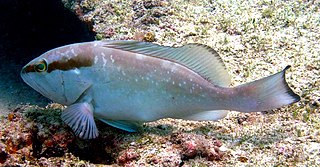
The red grouper is a species of marine ray-finned fish, a grouper from the subfamily Epinephelinae which is part of the family Serranidae, which also includes the anthias and sea basses. It is found in the western Atlantic Ocean.

Glossogobius giuris, the tank goby, is a species of goby native to fresh, marine and brackish waters from the Red Sea and East Africa through South Asia and the Indian Ocean to China, Australia and the islands of the Pacific Ocean. This species can also be found in the aquarium trade. It is also known as the bar-eyed goby, flat-headed goby and the Gangetic tank goby.

Hector's goby is a species of goby native to the Indian Ocean to the islands of Micronesia in the western Pacific Ocean. It can be found on sheltered coral reefs at depths of from 3 to 30 metres. This species reaches a length of 8.5 centimetres (3.3 in) SL. It can also be found in the aquarium trade. The specific name honours Gordon Hector who was Chief Secretary to the Government of the Seychelles, in gratitude for his help to Smith's work in the Seychelles.

Elacatinus puncticulatus is a species of goby from the eastern central Pacific Ocean, where it is found on reefs from the Gulf of California to Ecuador. This species occurs at depths ranging from 1 to 21m, and usually in association with the sea urchin Eucidaris thouarsii. The size of the goby varies depending on sex, with females being typically smaller than males, and their geographical location as well as their role as a cleaner goby also has impacts on their morphology. Due to their bright coloration and lack of aggression, the species is commonly found in the aquarium trade.
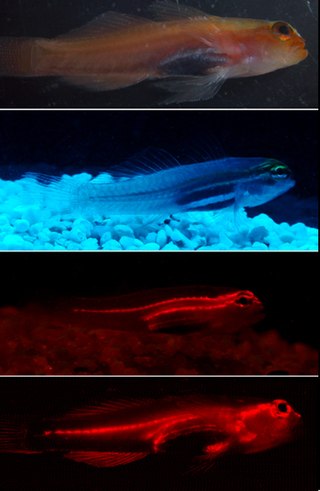
Eviota pellucida, commonly called neon pygmy goby or pellucida pygmy goby, is a species of marine fish in the family Gobiidae.

Trimma cana, the Candy cane pygmy-goby, is a species of goby native to the western Pacific Ocean where it can be found from the Philippines to Palau. It inhabits steep slopes on the outer side of reefs, preferring a hard coral substrate, at depths of from 12 to 35 metres. This species can reach a length of 2.5 centimetres (0.98 in) SL.

Gobiodon histrio, the Broad-barred goby, is a species of goby native to the Indian Ocean from the Red Sea to the western Pacific Ocean to southern Japan, Samoa and the Great Barrier Reef. This species is a reef dweller, being found at depths of from 2 to 15 metres. It can reach a length of 3.5 centimetres (1.4 in) TL. This species can also be found in the aquarium trade.

Bryaninops is a tropical Indo-Pacific genus of gobies. The genus takes its common name from the fact that it is commensal on gorgonians and black coral. The genus is further characterised by cryptic colouration.

Elacatinus evelynae, the sharknose goby, Caribbean cleaner goby, Caribbean cleaning goby, is a species of goby native to the Western Atlantic Ocean from the Bahamas and the Lesser Antilles to the northern coast of South America, as well as the Antilles and western Caribbean.

Bryaninops yongei, the wire-coral goby or whip coral goby, is a benthic species of goby widely distributed from the tropical and subtropical waters of the Indian Ocean to the islands in the center of the Pacific Ocean.
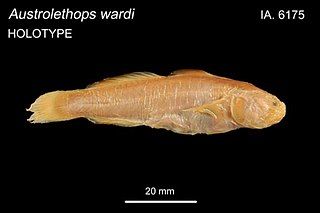
The small-eyed goby is a species of goby native to tropical reefs of the Indian Ocean through the western Pacific Ocean where it inhabits areas of coral rubble. As its common name suggests, this species has particularly small eyes. This species grows to a length of 6 centimetres (2.4 in) TL. This species is the only known member of its genus. The small-eyed goby is specialised to feed on seagrass and they share a burrows with mud lobsters of the genus Thalassina. The specific name honours Charles Melbourne Ward (1903-1966), the Australian actor, naturalist and collector of specimens who collected the type specimen.

Valenciennea helsdingenii is a species of goby from the Indo-Pacific. It is commonly known as the twostripe goby, black-lined sleeper goby, or railway sleeper goby. It can grow up to a length of 25 cm (9.8 in) and is distinguishable by two prominent orange to black lines running longitudinally through its body.

The largetooth goby, also known as Wilbur's goby, is a species of ray-finned fish from the family Gobiidae which is native to the Indo-Pacific from the Seychelles to Micronesia. Its known range has been extended to the Red Sea as specimens were photographed at one site and collected at another site off Egypt. This species lives in sheltered marine waters at depths of from 0 to 20 metres preferring areas with sandy substrates. This species grows to a length of 6.5 centimetres (2.6 in) SL. This species is the only known member of its genus. This species is not obviously sexually dimorphic and it has a background colour of pale brown to greenish-brown and a pale ventral side. The body is marked with brown and white spots, pairs of larger brown spots create a mid-lateral row along its flanks and there is a dark spot on the caudal fin peduncle. It has a brown blotch on the cheek and a series of short brown bars along its back. The largetooth goby is a solitary fish which is found in coastal bays, lagoons and estuaries over fine sandy substrates close to the margins of reefs or silt beds in the vicinity of sheltered and often turbid coastal reefs. It is most frequently collected from shallow waters to 7 metres (23 ft), around coral reefs but off southern Japan, the largetooth goby occurs at the bottom of sandy bays. The specific name honours the American physician, Ray Lyman Wilbur (1875–1949) who was president of Stanford University from 1916–1943, as well as being the United States Secretary of the Interior from 1929–1933. Wilbur helped the author, Herre, get to Palau, the type locality of this species.
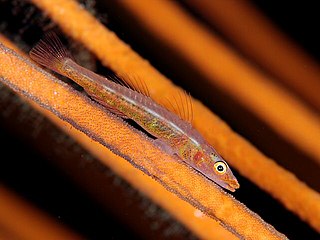
Bryaninops amplus, known commonly as the large whip goby or white-line seawhip goby, is a species of marine fish in the family Gobiidae.

Bryaninops natans, known commonly as the redeye goby, is a species of marine fish in the family Gobiidae.
Trimma tevegae, commonly known as the bluestripe pygmygoby or blue-striped cave goby among other names, is a species of goby from the western Pacific. They are small fish, averaging at 2 cm (0.79 in), orange-brown with white undersides in life, with characteristic iridescent blue or lavender stripes on the sides and on top of the body. They are usually found in large schools in the sloping or vertical drop-offs at coral reef edges. They are sometimes caught for the aquarium trade, and are also known by hobbyists under the name blue line flagtail goby. The species is named in honor of the schooner Te Vega.
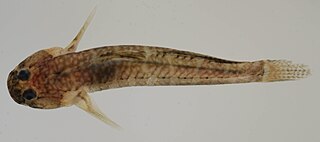
The seaboard goby is a species of fish belonging to the family Gobiidae.
Gobitrichinotus radiocularis is a species of goby which is found in the Indian and Pacific oceans, including the Ryukyu Islands in Japan, Philippines, the Solomon Islands, French Polynesia, and Vanuatu.

Pleurosicya mossambica, also known as the toothy goby or the Mozambique ghost goby, is a small species of goby native to the tropical Indo-West Pacific region. It was first described by South African ichthyologist J.L.B. Smith in 1959. Like many other gobies, it forms commensal relationships with several other marine invertebrates, including soft corals and sponges.
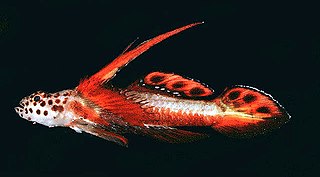
Discordipinna griessingeri is a small, brightly colored, marine neritic fish in the family Gobiidae that is commonly called the spikefin goby or flaming prawn goby. Occasionally it is mislabeled as "Stonogobiops griessingeri" which is a binomial species name that does not formally exist. The spikefin goby has a wide distribution across reefs throughout the western tropical Pacific, Pacific Islands such as Hawai'i and Polynesia, the Indian Ocean and the Red Sea. It is also occasionally collected and traded as an exotic aquarium fish in multiple countries.


















